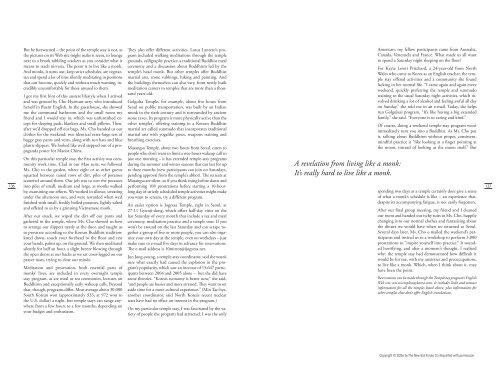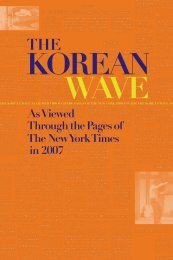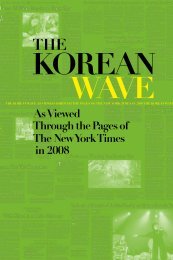The Korean Wave 2006 - Korean Cultural Service
The Korean Wave 2006 - Korean Cultural Service
The Korean Wave 2006 - Korean Cultural Service
Create successful ePaper yourself
Turn your PDF publications into a flip-book with our unique Google optimized e-Paper software.
136<br />
But be forewarned – the point of the temple stay is not, as<br />
the pictures on its Web site might make it seem, to lounge<br />
next to a brook nibbling crackers as you consider what it<br />
means to reach nirvana. <strong>The</strong> point is to live like a monk.<br />
And monks, it turns out, keep strict schedules, are vegetarian<br />
and spend a lot of time silently meditating in positions<br />
that can become, quickly and without much warning, incredibly<br />
uncomfortable for those unused to them.<br />
I got my first hint of this austere lifestyle when I arrived<br />
and was greeted by Cho Hyemun-aery, who introduced<br />
herself in fluent English. In the guesthouse, she showed<br />
me the communal bathroom and the small room my<br />
friend and I would stay in, which was unfurnished except<br />
for sleeping pads, blankets and small pillows. <strong>The</strong>n,<br />
after we’d dropped off our bags, Ms. Cho handed us our<br />
clothes for the weekend: two identical extra-large sets of<br />
baggy gray pants and vests, along with sun hats and blue<br />
plastic slippers. We looked like we’d stepped out of a propaganda<br />
poster for Maoist China.<br />
On this particular temple stay, the first activity was community<br />
work time. Clad in our Mao suits, we followed<br />
Ms. Cho to the garden, where eight or so other guests<br />
squatted between raised rows of dirt, piles of potatoes<br />
scattered around them. Our job was to sort the potatoes<br />
into piles of small, medium and large, as monks walked<br />
by, examining our efforts. We worked in silence, sweating<br />
under the afternoon sun, and were rewarded when we’d<br />
finished with small, freshly boiled potatoes, lightly salted<br />
and offered to us by a grinning Vietnamese monk.<br />
After our snack, we wiped the dirt off our pants and<br />
gathered in the temple, where Ms. Cho showed us how<br />
to arrange our slippers neatly at the door, and taught us<br />
to prostrate according to the <strong>Korean</strong> Buddhist tradition:<br />
kneel down, touch your forehead to the floor and rest<br />
your hands, palms up, on the ground. We then meditated<br />
silently for half an hour, a slight breeze blowing through<br />
the open doors at our backs as we sat cross-legged on our<br />
prayer mats, trying to clear our minds.<br />
Meditation and prostration, both essential parts of<br />
monks’ lives, are included in every overnight temple<br />
stay program, as are meal or tea ceremonies, lectures on<br />
Buddhism and exceptionally early wakeup calls. Beyond<br />
that, though, programs differ. Most average about 30,000<br />
South <strong>Korean</strong> won (approximately $33, at 972 won to<br />
the U.S. dollar) a night, but temple stays can range anywhere<br />
from a few hours to a few months, depending on<br />
your budget and enthusiasm.<br />
<strong>The</strong>y also offer different activities. Lotus Lantern’s program<br />
included walking meditations through the temple<br />
grounds, calligraphy practice, a traditional Buddhist meal<br />
ceremony and a discussion about Buddhism led by the<br />
temple’s head monk. But other temples offer Buddhist<br />
martial arts, stone rubbings, hiking and painting. And<br />
the buildings themselves can also vary, from newly built<br />
meditation centers to temples that are more than a thousand<br />
years old.<br />
Golgulsa Temple, for example, about five hours from<br />
Seoul on public transportation, was built by an Indian<br />
monk in the sixth century and is surrounded by ancient<br />
stone caves. Its program is more physically active than the<br />
other temples’, offering training in a <strong>Korean</strong> Buddhist<br />
martial art called sunmudo that incorporates traditional<br />
martial arts with yogalike poses, weapons training and<br />
breathing exercises.<br />
Musangsa Temple, about two hours from Seoul, caters to<br />
people who don’t want to limit a wee-hours wakeup call to<br />
just one morning – it has extended temple-stay programs<br />
during the summer and winter seasons that can last for up<br />
to three months (new participants can join on Saturdays,<br />
pending approval from the temple’s abbot). <strong>The</strong> retreats at<br />
Musangsa are silent, so if you think rising before dawn and<br />
performing 108 prostrations before starting a 10-hourlong<br />
day of strictly scheduled temple activities might make<br />
you want to scream, try a different program.<br />
An easier option is Jogyesa Temple, right in Seoul, at<br />
27-11 Gyunji-dong, which offers half-day visits on the<br />
last Saturday of every month that include a tea and meal<br />
ceremony, meditation practice and a temple tour. If you<br />
won’t be around on the last Saturday and can scrape together<br />
a group of five or more people, you can also organize<br />
your own day at the temple, even on weekdays – just<br />
make sure to e-mail five days in advance for reservations.<br />
<strong>The</strong> e-mail address is 10mirror@ijogyesa.net.<br />
Jun Jong-young, a temple-stay coordinator, said she wasn’t<br />
sure what exactly had caused the explosion in the program’s<br />
popularity, which saw an increase of 15,647 participants<br />
between 2004 and 2005 alone – but she did have<br />
some theories. “Korea’s economy is better now,” she said,<br />
“and people are busier and more stressed. <strong>The</strong>y want to set<br />
aside time for a more cultural experience.” (Min Tae-hye,<br />
another coordinator, said North Korea’s recent nuclear<br />
tests have had no effect on interest in the program.)<br />
On my particular temple stay, I was fascinated by the variety<br />
of people the program had attracted. I was the only<br />
A revelation from living like a monk:<br />
It’s really hard to live like a monk.<br />
American; my fellow participants came from Australia,<br />
Canada, Venezuela and France. What made us all want<br />
to spend a Saturday night sleeping on the floor?<br />
For Kayte Lowri Pritchard, a 24-year-old from North<br />
Wales who came to Korea as an English teacher, the temple<br />
stay offered activities and a community she found<br />
lacking in her normal life. “I came again and again every<br />
weekend, quickly preferring the temple and sunmudo<br />
training to the usual Saturday night activities, which involved<br />
drinking a lot of alcohol and feeling awful all day<br />
on Sunday,” she told me in an e-mail. Today, she helps<br />
run Golgulsa’s program. “It’s like having a big extended<br />
family,” she said. “Everyone is so caring and kind.”<br />
Of course, doing a weekend temple-stay program won’t<br />
immediately turn you into a Buddhist. As Ms. Cho put<br />
it, talking about Buddhism without proper, consistent,<br />
mindful practice is “like looking at a finger pointing at<br />
the moon, instead of looking at the moon itself.” But<br />
spending two days at a temple certainly does give a sense<br />
of what a monk’s schedule is like – an experience that,<br />
despite its accompanying fatigue, is not easily forgotten.<br />
After our final group meeting, my friend and I cleaned<br />
our room and handed our itchy suits to Ms. Cho, happily<br />
changing into our normal clothes and fantasizing about<br />
the dinner we would have when we returned to Seoul.<br />
Several days later, Ms. Cho e-mailed the weekend’s participants<br />
and invited us to a workshop to perform 3,000<br />
prostrations to “inspire yourself into practice.” It sounded<br />
horrifying, and after a moment’s thought, I realized<br />
why: the temple stay had demonstrated how difficult it<br />
would be for me, with my anxieties and preoccupations,<br />
to live like a monk. Which, when I think about it, may<br />
have been the point.<br />
Reservations can be made through the Templestay program’s English<br />
Web site: www.templestaykorea.com. It includes links and contact<br />
information for all the temples listed above, plus information for<br />
other temples that don’t offer English translations.<br />
137<br />
Copyright © <strong>2006</strong> by <strong>The</strong> New York Times Co. Reprinted with permission.





